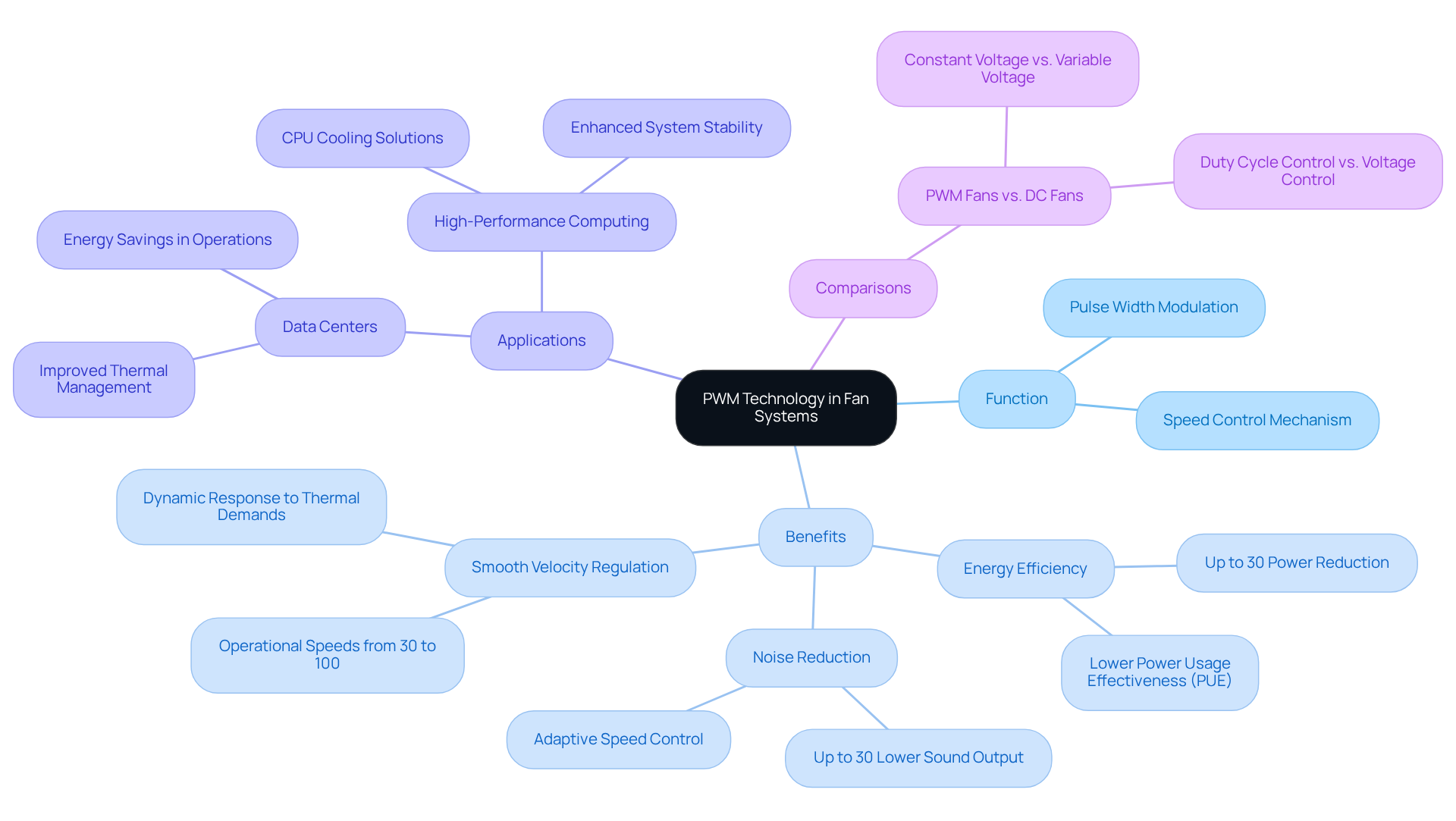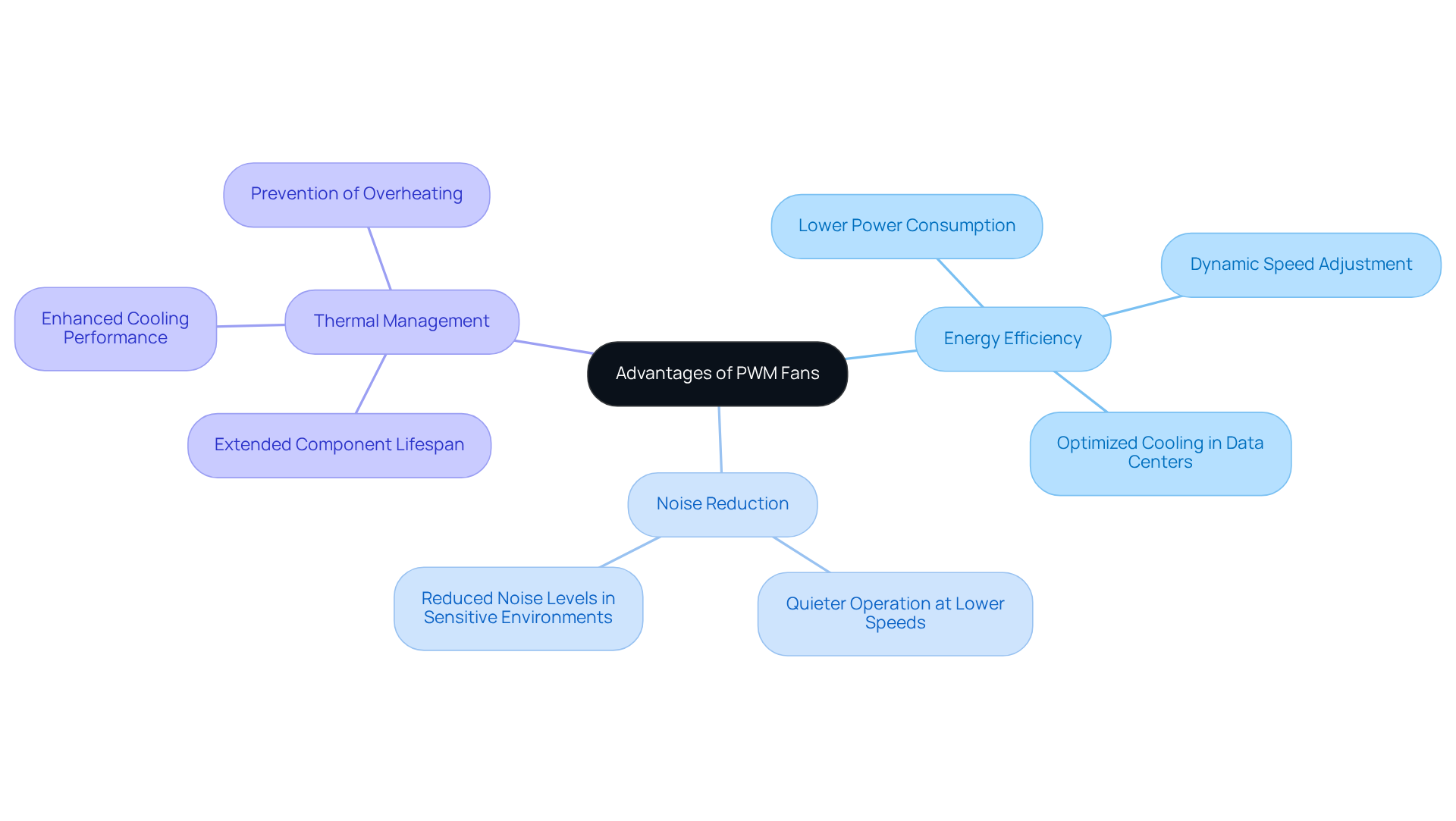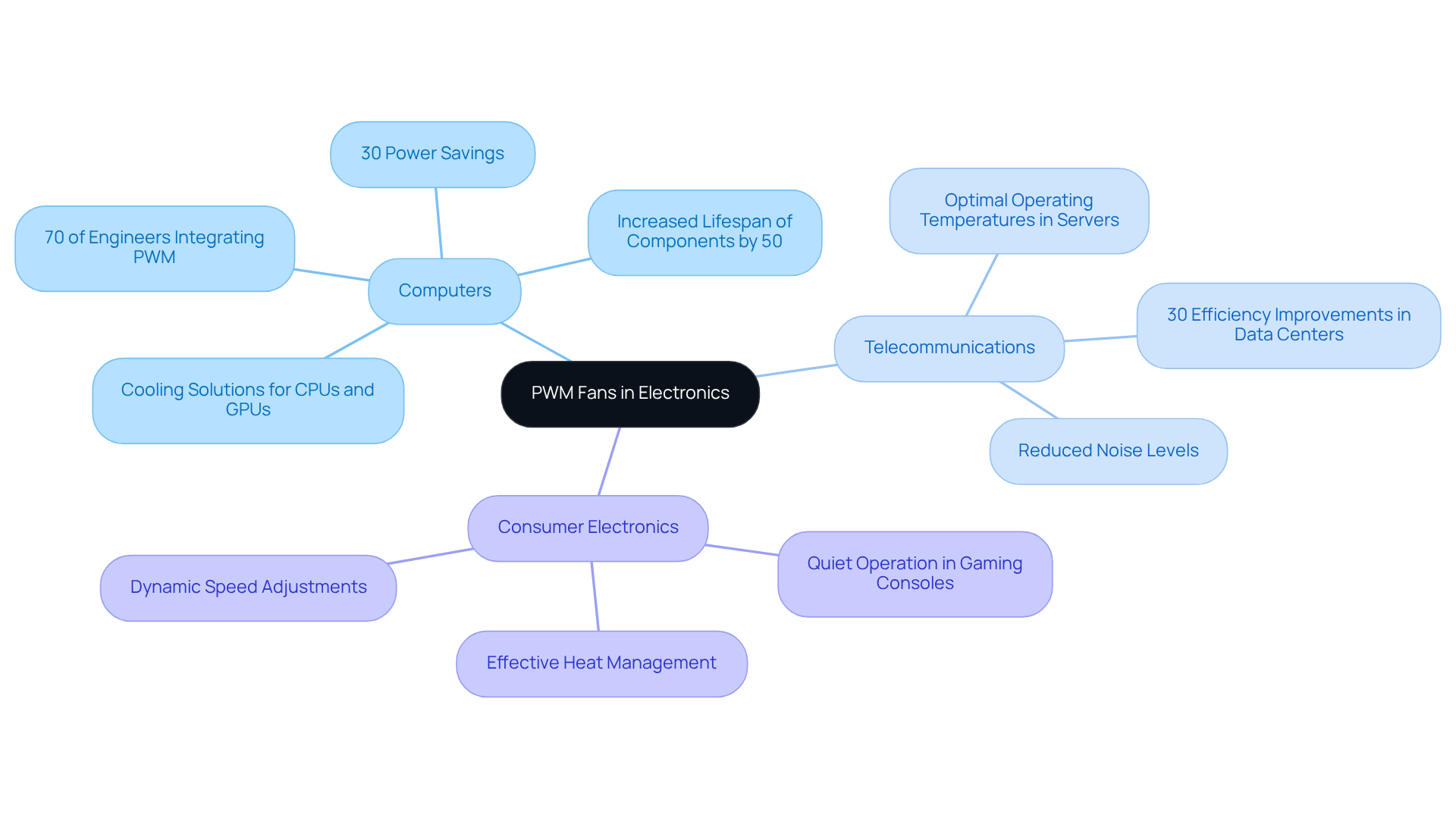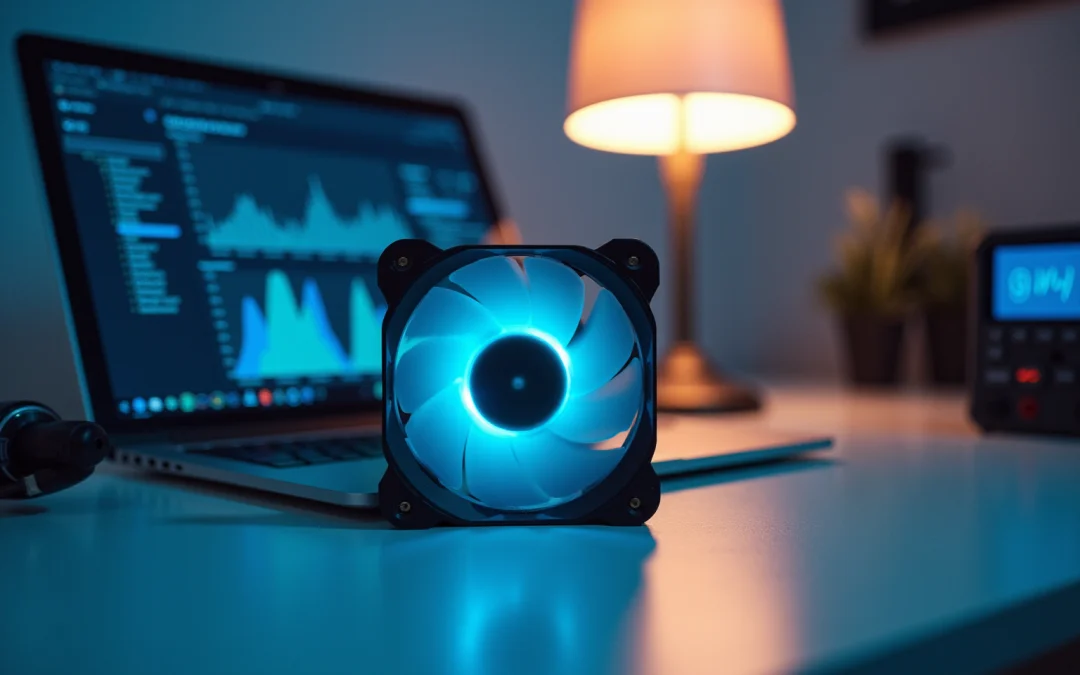Overview
The article elucidates that fan PWM (Pulse Width Modulation) technology represents a sophisticated method for regulating fan speed and efficiency. By adjusting the electrical pulse widths sent to the fan motor, this technology not only boosts energy efficiency but also significantly reduces noise levels. Evidence substantiates that PWM fans can diminish power consumption by as much as 30% compared to traditional fans. Furthermore, they enhance thermal management and promote quiet operation, rendering them indispensable in a variety of electronic applications, particularly within high-performance computing environments.
Introduction
The evolution of fan technology has ushered in a new era of efficiency and performance, with Pulse Width Modulation (PWM) leading the charge. This innovative approach not only optimizes fan operation but also significantly reduces energy consumption and noise levels, establishing itself as a game-changer across various electronic applications.
As the demand for quieter and more efficient cooling solutions continues to rise, a critical question emerges: how does PWM technology truly enhance fan performance, and what implications does it hold for the future of electronic cooling systems?
Define PWM Technology in Fan Systems
The illustrates how Pulse Width Modulation (PWM) technology in fan systems signifies a significant advancement in regulating fan performance by modifying the electrical pulse widths delivered to the fan motor. This innovative method facilitates , which relates to fan PWM meaning, allowing it to operate efficiently across varying conditions. The fan PWM meaning is achieved by rapidly switching the power supplied to the fan on and off, with the duration of the ‘on’ time—known as the pulse width—dictating the average power delivered. Consequently, this results in quieter operation and a marked reduction in energy consumption compared to traditional fan control methods, which typically depend on resistors or linear voltage regulation.
Real-world applications of underscore its effectiveness in . For example, studies reveal that can reduce power consumption by as much as 30% when compared to conventional models. Furthermore, practical experiments conducted in data centers have demonstrated a decrease in (PUE) from 1.55 to 1.42, showcasing the technology’s pivotal role in improving .
The benefits of [PWM technology](https://gagner-toomey.com/10-key-benefits-of-pwm-fans-for-electronics-engineers) extend beyond mere energy conservation; it also provides smooth velocity regulation, enabling devices to operate at reduced noise levels while adaptively responding to thermal demands. This adaptability is crucial in environments where noise sensitivity is paramount, as PWM units can lower sound output by up to 30% relative to traditional cooling methods. Additionally, the incorporation of a fourth wire in PWM devices allows for precise speed regulation, enabling them to sustain operational speeds ranging from 30% to 100% of their rated capacity.
In conclusion, the fan PWM meaning signifies a transformative development in , offering engineers innovative solutions for efficient cooling across various applications, particularly in high-performance computing environments.

Evaluate Advantages of PWM Fans Compared to Traditional Fans
The advantages of PWM blowers, which are explained by , include significant improvements in , noise reduction, and compared to conventional models. , reflecting the fan PWM meaning, can substantially lower power consumption by dynamically adjusting their speed based on temperature or system demands—an essential feature for .
Research indicates that PWM devices operate more quietly at reduced speeds compared to traditional models, which often run at fixed high speeds and produce elevated noise levels. This quality renders PWM units particularly suitable for settings where sound levels are paramount, such as in home electronics and medical equipment. Furthermore, the fan PWM meaning is illustrated by , which employ a 4-pin connector for power, ground, tachometer, and PWM signal, whereas traditional DC fans generally utilize a 3-pin connector for power, ground, and tachometer.
In addition, the , which is a key aspect of fan PWM meaning, enabled by , ensuring that electronic components maintain optimal operating temperatures. This capability not only mitigates overheating but also extends the lifespan of these components by as much as 50%, given that efficient cooling is vital for stability.
In high-demand scenarios, such as gaming PCs and data centers, PWM units can ramp up their speed under heavy loads, delivering essential cooling while minimizing energy waste. For instance, case studies have shown that improve energy efficiency in data centers by optimizing cooling power per server, leading to reduced electricity costs and increased reliability.
Ultimately, into electronic systems fosters enhanced performance, lower operational costs, and a quieter, more efficient environment. As one expert noted, “PWM devices are however the more advanced type that is efficient as well,” underscoring their superiority in contemporary cooling solutions.

Explore Applications of PWM Fans in Electronics
Understanding is important, as PWM ventilators play a crucial role across various electronic applications, including computers, telecommunications equipment, and consumer electronics. In computer systems, understanding is indispensable for aimed at CPUs and GPUs, where is essential for achieving optimal performance.
Recent statistics reveal that over 70% of electronics engineers are now integrating into their designs, underscoring their increasing importance in the industry. Moreover, understanding the fan PWM meaning reveals that can compared to direct current devices, emphasizing their efficiency advantages.
In telecommunications, understanding fan PWM meaning is essential as PWM devices are utilized to maintain optimal operating temperatures in densely populated server environments, where . For instance, in data centers, the shift to has resulted in of up to 30%.
Additionally, consumer electronics, such as gaming consoles and home theater systems, benefit from PWM fans, which highlights the fan PWM meaning by ensuring quiet operation while effectively managing heat. The versatility of PWM technology, which encompasses fan PWM meaning, spans applications from industrial machinery to portable devices, highlighting its essential role in the electronics landscape.
As Matt Safford aptly notes, “The accuracy of PWM devices enables engineers to enhance temperature management strategies efficiently, which is crucial in high-performance settings.

Conclusion
The exploration of fan PWM meaning reveals a transformative approach to fan control systems, underscoring the significant advantages of Pulse Width Modulation (PWM) technology in enhancing performance and efficiency. By adjusting the electrical pulse widths delivered to fan motors, PWM technology optimizes fan speed, contributes to quieter operation, and reduces energy consumption. This makes it a pivotal advancement in cooling solutions.
Key insights from the article highlight the benefits of PWM fans over traditional models, including:
- Substantial energy savings
- Noise reduction
- Improved thermal management
The ability of PWM devices to dynamically adjust their speed based on system demands facilitates effective cooling across various applications, ranging from high-performance computing to telecommunications and consumer electronics. Furthermore, the integration of PWM technology has led to notable improvements in operational efficiency, with studies indicating reductions in power consumption of up to 30% and an enhanced lifespan of electronic components.
Reflecting on broader implications, understanding fan PWM meaning extends beyond technical specifications; it emphasizes the importance of adopting advanced cooling solutions in an increasingly energy-conscious world. As industries prioritize efficiency and performance, embracing PWM technology fosters innovation and contributes to sustainable practices in electronic design and operation. The transition to PWM fans is not merely a trend but a necessary evolution in ensuring optimal performance and energy efficiency across diverse applications.
Frequently Asked Questions
What does PWM stand for in fan systems?
PWM stands for Pulse Width Modulation, a technology used to regulate fan performance by modifying the electrical pulse widths delivered to the fan motor.
How does PWM technology improve fan performance?
PWM technology allows for precise control over the fan’s rotation rate by rapidly switching the power supplied to the fan on and off, resulting in quieter operation and reduced energy consumption compared to traditional methods.
What are the advantages of using PWM over traditional fan control methods?
PWM technology can reduce power consumption by as much as 30%, provides smoother velocity regulation, allows for adaptive responses to thermal demands, and can lower sound output by up to 30%.
What is the significance of the fourth wire in PWM devices?
The fourth wire in PWM devices enables precise speed regulation, allowing the fan to maintain operational speeds ranging from 30% to 100% of its rated capacity.
How effective is PWM technology in real-world applications?
Studies have shown that PWM devices can significantly enhance fan efficiency, as demonstrated by a decrease in Power Usage Effectiveness (PUE) in data centers from 1.55 to 1.42.
In what environments is PWM technology particularly beneficial?
PWM technology is especially beneficial in environments where noise sensitivity is important, such as high-performance computing environments, due to its ability to operate at lower sound levels.

